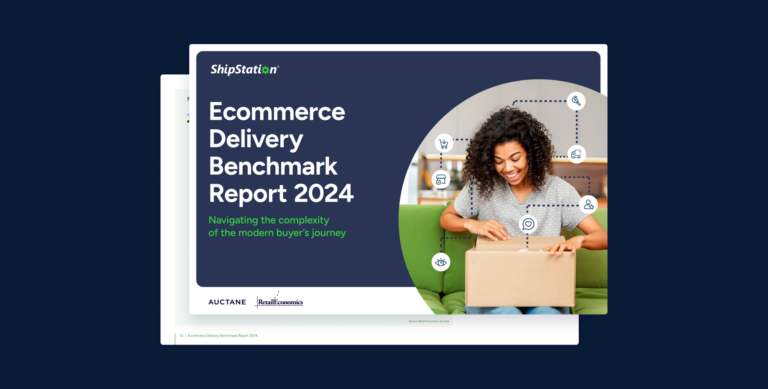Boost Sales with the Branded Returns Portal (+ 5 More Benefits)

Yes, we’re talking returns again. Your least favorite topic. But we have to discuss it.
Returns are the “bad cholesterol” of ecommerce. They clog your company’s operational arteries. And they can kill your business if not properly managed.
You might think: “I know what you’re going to say. You’ll tell me to learn from Zappos and offer free returns. But my company isn’t anything like Zappos.”
We get that. That’s why the data and examples in this analysis are from small and medium-sized ShipStation businesses like yours. In this article, we’ll review merchants’ sales volume as well as returns processes and policies. And we’ll show you the improvements these merchants made along the way.
You’ll see six strong reasons to optimize your returns game before Q4 craziness kicks in. And yes, all six work great without free returns and won’t increase your costs.
Want to boost your online sales volume by 16% just with a few mouse clicks? Then let’s dig right in.
1. Increase Conversion Rate by 16% with Easy Returns
Before opening their wallets, 66% of online shoppers look at a store’s return policy. It’s part of a risk-reward assessment before committing to a purchase. If they can more easily picture waiting in line at the postal office to return unwanted items than getting compliments for their new outfit, they’ll bail. It’s simply how we all make decisions.
And a particular barrier for smaller businesses that sell unique products like APEMAN STRONG. “Our site visitors can’t feel fabrics or try on sizes,” explained APEMAN STRONG owner Adam Field. “They take risks and I want them to feel comfortable about it. So we just decided to offer absolutely hassle-free returns.”
This policy, paired with the activation of ShipStation’s Branded Returns Portal, showed the company’s confidence in their products. It complemented the brand’s theme of strength and converted quitters into buyers. “These changes increased cart conversion from 40% to 45%,” Field noticed. “And average order value rose by approximately $10.”
Best of all: “Half of the shoppers now add another T-shirt which helps with profits and and keeping prices low,” said Field “It did not increase the number of returns so I really don’t see a downside.”
In addition to updating their return policy, APEMAN STRONG started using ShipStation’s Branded Returns Portal. The decision emphasized the brand’s commitment to improving every part of the purchase and post-purchase experiences. And it further proved APEMAN STRONG’s dedication to the satisfaction of their customers.
APEMAN STRONG’s success with the returns portal is a typical result for ShipStation users. After implementing the feature, the median increase for average order volume per store was 16%. Brands with a ShipStation Silver Plan or Enterprise Plan saw increases of 18% and 19.7%, respectively.
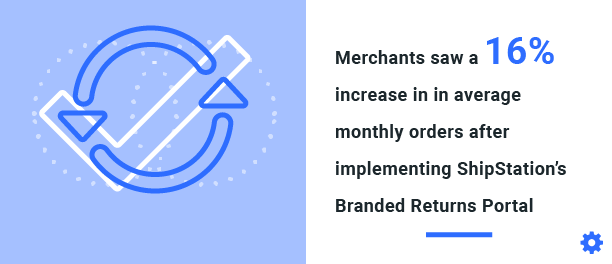
2. You Don’t Need to Offer Free Returns to Boost Sales
Comfort One Shoes is a family-owned shoe retailer in Washington, D.C. After being in business for 25 years, the team at Comfort One Shoes understands their audience well.
“We don’t charge for exchanges,” said Karolyn Stewart, Ecommerce Manager at Comfort One Shoes. “And we only charge $9.75 for returns.” According to Stewart, “many shoppers are more bothered by the hassle of buying the right label than the costs.” Knowing this, the retailer makes it easy to return or exchange items with the ShipStation Branded Returns Portal.
In the website header, Comfort One Shoes promotes their straightforward returns policy:

Clicking on “Easy Returns. Free Exchanges.” redirects customers to the self-service returns portal:
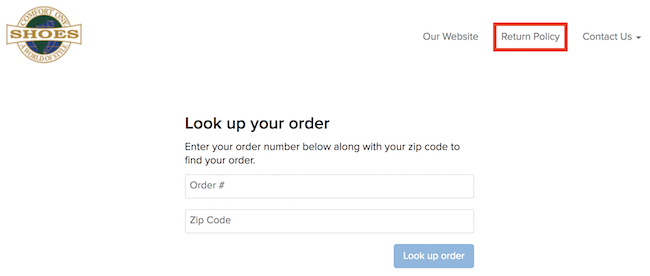
On this page, shoppers can also click on “Return Policy” and view the retailer’s complete returns policy:

Actively promoting an easy and customer-friendly policy — and providing a link to the returns portal— makes a big difference for Comfort One Shoes and many others.
Shoppers also have the option to return or exchange orders at one of the store’s brick-and-mortar locations.
3. Decrease Returns Volume with a Systematic Approach
Returns are expensive. Rarely anything cuts into your bottom line as brutally as this combination of lost revenue, wasted postage, and – worst case – an unsaleable returned item. Not to mention the handling efforts around these steps.
APEMAN STRONG mainly sells T-shirts for $25 each. “With free shipping and handling both ways, an exchange involves three labels,” explained Field. “There would not be any profit left if I did not reduce returns as much as I can by studying the ‘why’.”
“Based on feedback, we reshot some product images if the colors were off. We detailed out how our 60/40 cotton blend feels and explained what ‘athletic fit’ meant.” Field is proud to have a “less than 5% return rate” which is unusually low for apparel. What did he do to achieve that? “Do only what you do best. Listen to the feedback. Be detailed, be honest, and be absolutely clear on what the product is and does.”
This may be harder than it sounds but the good news is help is available and it’s free! Customers dislike returns almost as much as retailers. So it makes sense to work with your audience to improve products and listings to make sure the next order is right the first time.
Another good example of how website updates can decrease returns comes from Encircled. Kendra Hilker, Brand Experience Manager at the Canadian fashion retailer, explained:
“One of our dresses, The Chrysalis Cardi, comes in three sizes: petite, regular, and maxi. Originally on our website, we had a size chart that read like a spreadsheet. It was all columns and rows.”
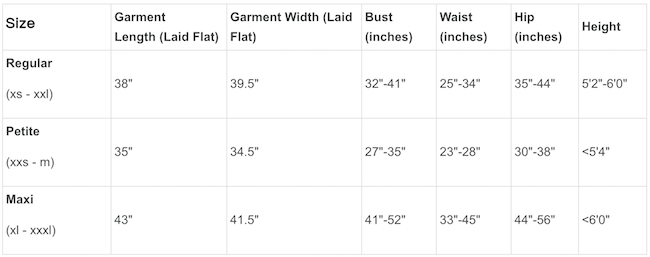
Encircled’s Original Size Chart
“Since we grouped XS-XXL into three sizes, some customers ordered the wrong one,” according to Hilker. “This led to a lot of returns, which we tracked through our returns portal. We decided to simplify the chart and we’ve noticed a significant decline in returns due to sizing issues.”
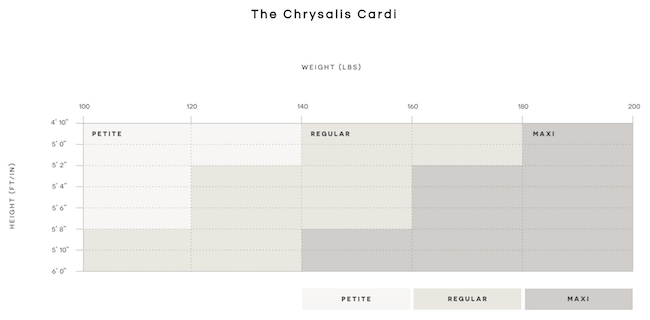
Encircled’s Updated Size Chart
Size and color issues are the #1 reason for returns in apparel. Size charts help, especially if a merchant has a specific sizing concept.
4. A Good Returns Experience Encourages Repeat Purchases
Merchants spend a lot of time and money attracting customers. Ideally, loyal customers. Does the quality of the returns process impact a shopper’s willingness to buy again? It does. And we have the data to prove it.
We reviewed the rates of repeat purchases before and after stores launched their Branded Returns Portal. We found shoppers were 28.8% more likely to order from the same merchant again after returning an item through a self-service portal.
Using the self-service returns portal had a substantial impact on smaller business in particular. Prior to implementing the Branded Returns Portal, only 15.5% of customers who made a return bought from the retailer again. However, once these ShipStation Bronze plan users launched the self-service returns portal, repeat purchases from returners increased by 60%.
This dramatic lift flattened towards higher-volume sellers but even Enterprise accounts still saw a solid 10% increase. On average, merchants benefited from a 28.8% improvement compared to stores without this feature.
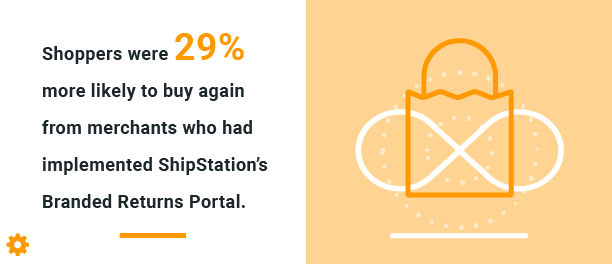
5. Use “Reason for Return” as an Overall Health Check for Your Company
Returns often seem to be driven by a customers’ “change of mind” (29.9%) or they “ordered the wrong item” (13.7%). And indeed, when asked on the Branded Returns Portal, these were the two most common reasons.
But these certainly don’t account for all returns. In fact, nearly a quarter of customers said the merchant was at fault. And the complaints touch pretty much all aspects of an ecommerce business:
- Items weren’t as described: 9.4%
- Items were defective: 5.7%
- Received the wrong item: 3.7%
- Order arrived late: 3.2%
- Items were damaged: 2.7%
Remember: these numbers are based on customer perceptions. So take them with a grain of salt. But looking at individual stores and their data, we clearly noticed how some merchants did a better job listing, picking, packing, and shipping than others. And we are being diplomatic here. Tracking down these pain points and identifying patterns around certain SKUs (or staff members!) is critical to reduce returns and losses associated with them. It will also guide you to build a better, more customer-centric company.
The fix may be as simple as uploading better product photos. Or maybe you need to upgrade your packaging or partner with a different shipping provider. It could also be a more serious issue, such as the need to retrain your staff or find a new supplier altogether. Unbiased data will guide the way; it’s up to you then to “turn data into doing.”
6. No More Pre-Printed Return Labels
“Before we had ShipStation’s Branded Returns Portal, we pre-printed a return label for every order,” remembered Field. “We didn’t have the volume we have now. But it still was a waste of paper and time. Especially since only 5% of the return labels were used.”
“We were also losing money on the overhead costs of return authorizations,” Field continued. “And the time we spent sending emails and making calls added up to many hours per week.”
Several other merchants confirmed shifting returns to a self-service portal reduced the hassle of returns. And they maintained full control over what could be returned and how long after the purchase. It’s difficult to quantify exactly how much time our users save with the self-service returns portal. But what we can measure is the number of return labels merchants have had to void as unused.
After launching the Branded Returns Portal, merchants voided anywhere from 41% to 70% fewer return labels. Not only does this save plenty of trees every year, but it also enables merchants to focus on more important things.
“Every hour saved is an hour I can focus on strengthening my brand. And strengthening my relationships with the UFC athletes we sponsor,” said Field. “I’d much rather create or promote another episode of APEMAN UNCAGED than deal with ‘reverse logistics’,” he laughed.
This is right at the heart of what we want at ShipStation: to provide “big retailer efficiency” to everyone. We want merchants to be free to do what matters in growing their companies.
So how do you manage returns? Care to share your data points or suggestions? Comment below or email [email protected].
Checklist
If you want to see similar or even better results than those above, here’s what to do:
- Review your overall policy. Define one that makes sense for your brand based on your industry, margin, competition, and return costs.
- Be transparent about your returns policy. And place it prominently on your site. Even a strict but clear policy is better than keeping shoppers in the dark.
- Activate the ShipStation Branded Returns Portal – it is included in your plan – and add your rules to it. You can exclude certain items and define your returns window, e.g. 30 days.
- Track return reasons in “Insights” and share them with the company. Make them actionable improvement opportunities for all teams.
Pro Tip: If you suspect that many returns are due to staff errors, run the “Returned Products report”, and manually cross reference the “Outbound Shipping” column with the “Tracking Number” column for a Shipment Export / Shipped Orders report. You’ll then see which colleague needs a training.

